DERMATOLOGICAL SERVICES
The DiGiovanna Family Health and Wellness Center recognizes the importance of the skin and skin structures. Skin is the largest organ in the body, and it performs many vital functions. Keeping the skin healthy, and being able to recognize the changes in skin that occur with certain diseases, has become an important aspect of the Primary Care Services the the DiGiovanna Family Health and Wellness Center provides. Some of the dermatological services and procedures offered by the DiGiovanna Family Health and Wellness Center are as follows.
Skin Cancer Surveillance
Skin cancer is the most common cancer of both men and women. The most common cause of skin cancer is sun exposure. One is the most deadly cancers are melanomas, which are a form of skin cancer. The most common form of skin cancer is basal cell carcinomas, of which an estimated 4.3 million cases are diagnosed in the United States each year, leading to more than 3,000 deaths per year. Squamous cell carcinoma is the second most common form of skin cancer. The DiGiovanna Family Health and Wellness Center maintains a program of skin cancer screening, where the entire body is scanned with the help of a magnified headlight. Growths which may have the potential of becoming cancerous are documented and monitored regularly. Growths or areas which are suspicious for skin cancer receive a punch biopsy. The punch biopsy removes a small piece of the suspicious area, which is then sent to a dermatopathology laboratory for further identification. If skin cancer is identified, the patient may then be referred to an appropriate specialist for surgical removal. Education and instruction are provided for prevention of skin cancers, such as avoidance of prolonged sun exposure, proper use of sun blocks, and recognizing those skin lesions which should be brought to a physician’s attention.
Condyloma Acuminata
Condyloma acuminata, or genital warts, are caused by a viral infection called Human Papilloma Virus (HPV). HPV infections are the most common sexually transmitted disease. The condylomata appear as tiny growths, or skin tags, around the genitalia, inner thighs and perianal areas. If left untreated, the condyloma may continue to spread throughout the perineal area, be contagious to other that come in contact with them, and lead to certain types of cancers, like cervical cancer in women. The DiGiovanna Family Health and Wellness Center maintains several means of destroying these condylomata. Cryotherapy, where the growths are temporarily exposed to extremely cold temperatures through a specially designed probe, will kill the condylomata, which will subsequently fall off. Many lesions may be treated at a single visit. Hyfrecator therapy is where the lesions are exposed to thermal energy through a probe connected to an electrical generator. This very high heat burns the lesions, which disintegrate on contact. Trichloroacetic acid is an acid-based, gel-like liquid which is placed on the condylomata and left for a few minutes to destroy the lesions. The acid is washed off with soapy water after treatment. The advantage of this treatment is the destruction of the virus along with the lesion.
Chronic Idiopathic Urticaria
About 20% of people get hives — itchy red or skin-colored welts also known as urticaria. They’re often caused by an allergic reaction to a food or drug. Usually, they go away quickly. For a small number of people, though, hives come back again and again, with no known cause. When new outbreaks happen almost every day for 6 weeks or more, it’s called chronic idiopathic urticaria (CIU). One percent or less of people have it. It’s most common in people between the ages of 20 and 40. With CIU, a single outbreak usually lasts no more than 24 hours. After that, new hives form. The cause is unknown. The immune system seems to play a role. Some people get chronic hives at the same time that they get other problems like thyroid disease, hormonal problems, or cancer. Even though we can’t say for sure what causes CIU, they do know things that can lead to flare-ups. They include:
- Alcoholic drinks
- Tight clothing
- Nonsteroidal anti-inflammatory drugs (NSAIDS) like aspirin and ibuprofen
- Exercise
- Cold
- Heat
The DiGiovanna Family Health and Wellness Center employs the latest studies and treatments to help people suffering from this chronic condition. One of the newer treatments that is administered by the DiGiovanna Family Health and Wellness Center is Xolair (Omalizumab) which is administered as monthly injections, and has been found to be very effective at controlling this condition. Other treatments, as well, may be employed to help control the itching and clear up the rash.
Psoriasis and Eczema
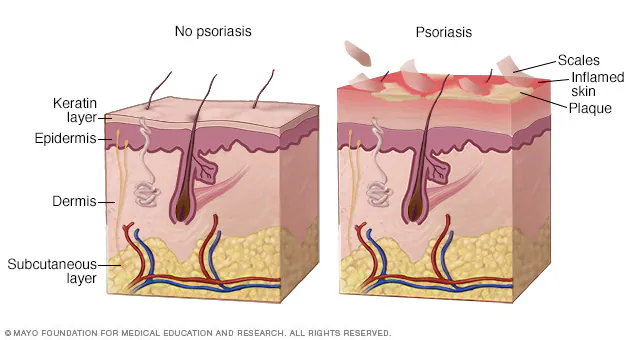
- Psoriasis is a common skin condition that speeds up the life cycle of skin cells. It causes cells to build up rapidly on the surface of the skin. The extra skin cells form scales and red patches that are itchy and sometimes painful.
Psoriasis is a chronic disease that often comes and goes. The main goal of treatment is to stop the skin cells from growing so quickly.
There is no cure for psoriasis, but you can manage symptoms. Lifestyle measures, such as moisturizing, quitting smoking and managing stress, may help.

Plaque psoriasis
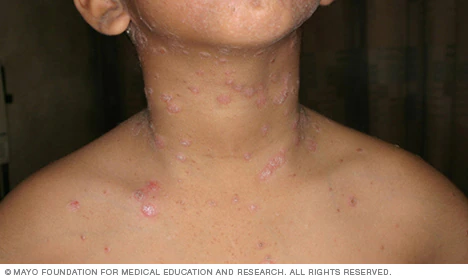
Guttate psoriasis
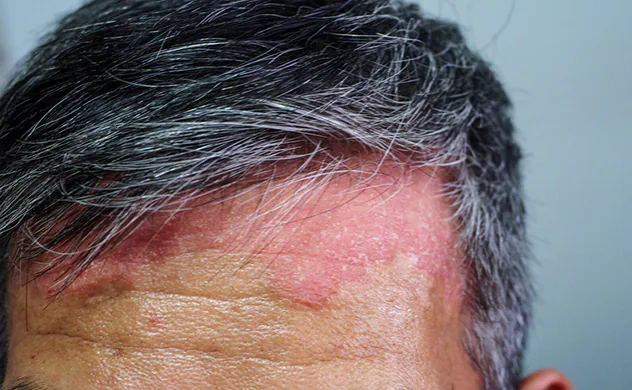
Scalp psoriasis
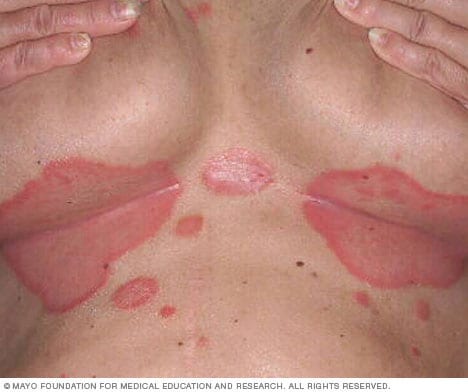
Inverse psoriasis

Nail psoriasis
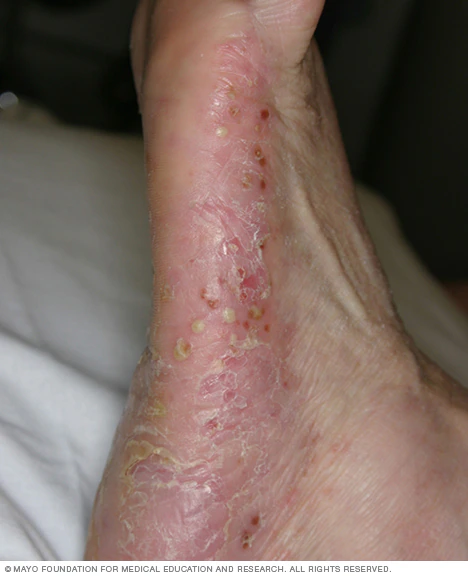
Pustular psoriasis
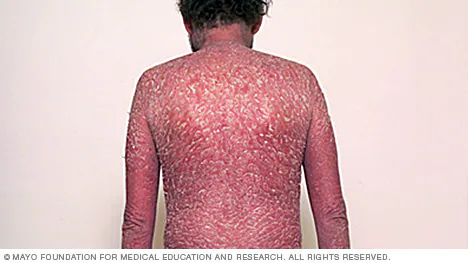
Erythrodermic psoriasis
Psoriasis signs and symptoms are different for everyone. Common signs and symptoms include:
- Red patches of skin covered with thick, silvery scales
- Small scaling spots (commonly seen in children)
- Dry, cracked skin that may bleed
- Itching, burning or soreness
- Thickened, pitted or ridged nails
- Swollen and stiff joints
Psoriasis patches can range from a few spots of dandruff-like scaling to major eruptions that cover large areas.
Most types of psoriasis go through cycles, flaring for a few weeks or months, then subsiding for a time or even going into complete remission.
There are several types of psoriasis. These include:
- Plaque psoriasis. The most common form, plaque psoriasis causes dry, raised, red skin lesions (plaques) covered with silvery scales. The plaques might be itchy or painful and there may be few or many. They can occur anywhere on your body, including your genitals and the soft tissue inside your mouth.
- Nail psoriasis. Psoriasis can affect fingernails and toenails, causing pitting, abnormal nail growth and discoloration. Psoriatic nails might loosen and separate from the nail bed (onycholysis). Severe cases may cause the nail to crumble.
Guttate psoriasis. This type primarily affects young adults and children. It’s usually triggered by a bacterial infection such as strep throat. It’s marked by small, water-drop-shaped, scaling lesions on your trunk, arms, legs and scalp.
The lesions are covered by a fine scale and aren’t as thick as typical plaques are. You may have a single outbreak that goes away on its own, or you may have repeated episodes.
- Inverse psoriasis. This mainly affects the skin in the armpits, in the groin, under the breasts and around the genitals. Inverse psoriasis causes smooth patches of red, inflamed skin that worsen with friction and sweating. Fungal infections may trigger this type of psoriasis.
Pustular psoriasis. This uncommon form of psoriasis can occur in widespread patches (generalized pustular psoriasis) or in smaller areas on your hands, feet or fingertips.
It generally develops quickly, with pus-filled blisters appearing just hours after your skin becomes red and tender. The blisters may come and go frequently. Generalized pustular psoriasis can also cause fever, chills, severe itching and diarrhea.
- Erythrodermic psoriasis. The least common type of psoriasis, erythrodermic psoriasis can cover your entire body with a red, peeling rash that can itch or burn intensely.
- Psoriatic arthritis. In addition to inflamed, scaly skin, psoriatic arthritis causes swollen, painful joints that are typical of arthritis. Sometimes the joint symptoms are the first or only manifestation of psoriasis or at times only nail changes are seen. Symptoms range from mild to severe, and psoriatic arthritis can affect any joint. Although the disease usually isn’t as crippling as other forms of arthritis, it can cause stiffness and progressive joint damage that in the most serious cases may lead to permanent deformity.
The DiGiovanna Family Health and Wellness Center employs many newer treatments and innovations for patients suffering from psoriasis and eczema. Beyond steroid creams and pills, some newer topical treatments have been developed and are currently being introduced into the treatment regimens of our psoriasis and eczema patients. In addition, Laser Genesis has been found to be very effective for both of these conditions and is also being offered by the DiGiovanna Family Health and Wellness Center.
Learn More About Laser Treatments & Aethestics
Onychomycosis (Toenail or Fingernail Fungus)
Onychomycosis is a fungal infection usually caused by a special type of fungus known as a dermatophyte. These sorts of fungi are generally confined to the dead, horny outer layers of the skin and gradually progress to involve the nail plate. Onychomycosis is particularly common in toenails of older men but can affect all of the nails of individuals of any age and sex. The treatment of this condition is complicated by the fact that these fungi live in dead tissue, and getting medications to these sites is problematic.
What is the traditional treatment of onychomycosis?
Because most of these infections are relatively superficial, it would seem that topical treatments ought to work well. This is not the case because the nail unit is relatively impenetrable. In addition, it is common for these infections to be entirely asymptomatic (not producing symptoms), which doesn’t seem to diminish the patient’s distress with the unpleasant appearance of the nail. A perfect treatment modality would be inexpensive, very effective, and very safe. Sadly, we have not achieved this perfect situation yet.
Currently accepted treatments include relatively ineffective topical therapies and oral treatments which are reasonably effective but are associated with some degree of risk. Both approaches require a long duration of treatment and the topical therapies in particular are somewhat costly. Most experts agree that surgical approaches like removing the nail plate are ineffective.
How does laser treatment work to treat onychomycosis?
It is into this environment that the use of lasers has been thrust. Of course, lasers are a very sexy, modern, technologically advanced approach to the treatment of a variety of human diseases. Lasers produce coherent light energy of a sufficient strength and of a specific wavelength, which when projected into tissue is differentially absorbed by the target material, producing heat and hence destroying tissues. Other tissue components are unaffected and so spared. The DiGiovanna Family Health and Wellness Center offers the latest laser technology for the treatment of nail fungus. Utilizing the Laser Genesis on mycotic nails can work alone, not only to cure the mycotic nail but improve the cosmetic result during treatment, but may also be used in conjunction with conventional oral antifungals to make therapy more efficient and effective.
